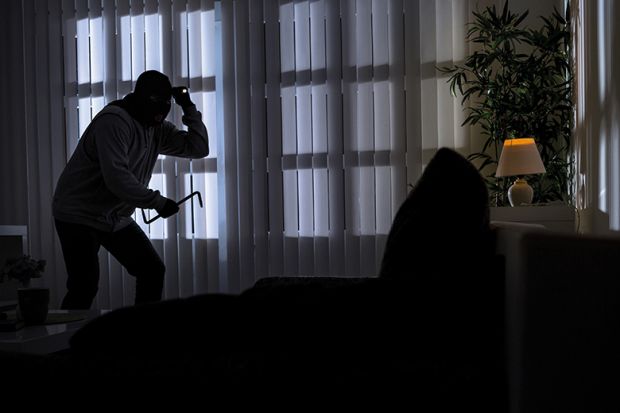Some time ago, we were burgled. The thieves got away with some cash. My parents were burgled and my dad lost his medals. My friend was burgled. The burglar stole his underpants…
Burglary is a deeply disturbing phenomenon, defined until 1968 as an act happening in the hours of darkness. Burglars steal objects of intrinsic worth or sentimental value, violating bedrooms, rifling through underwear and penetrating and defiling the intimate space of home. What they do is not just petty theft, but nearer to the destruction of personal security represented by the missing history of our daily lives: wedding rings, small family heirlooms and war medals. I had thought we were all simply crime statistics, but if you wait long enough it turns out that you become cultural history.
Crime is now academic big business. From bloody murders to glamorous jewel heists, the minutiae of trials and the lives of criminals form rich pickings for those who wish to weave narratives and lost biographies into the theoretical scholarship of feminism, ethnicity and class. The sociology of crime, whereby it is fitted into a specific historical setting, is now also aligned to the cultural context of its representations in literature and film, a combination that adds up to the rediscovery of the ordinary and everyday as both patterned and meaningful.
This is exactly what happens in Eloise Moss’ excellent new history of burglars and burglary, the result of meticulous research coupled with a style that is highly readable and often amusing. The book is packed with little details that bring it alive, in what might otherwise be a dry subject, but I won’t give away when the UK’s General Post Office invented the 999 emergency phone number or when the term “cat burglar” was coined by the press.
Moss’ book covers roughly a hundred years between 1860 and 1968 and analyses our ambivalent attitudes towards those who break into our homes at night. From the middle of the Victorian era, burglars (but not their daytime equivalent, housebreakers) became both the terror of the propertied classes and the focus of fantasies of athleticism, masculinity and eroticism. Starting with the notorious thief and murderer Charles Peace, whose exploits made him an unlikely folk hero well into the 20th century (he finally vanished from view when his waxwork effigy melted in the fire at Madame Tussaud’s), through the fictional hero A. J. Raffles, we are given insights not only into criminal behaviour but also into the technologies of prevention, those locks, bolts, alarms and safes that seem only to have increased the various crime waves.
The Elizabethan jurist Sir Edward Coke, more or less, invented the saying “an Englishman’s home is his castle”, a phrase repeated by generations of middle-class suburban homeowners. Near where I live, there is a yellow Neighbourhood Watch sign warning housebreakers that this is a no-go area for criminals, with a silhouette of a comic-book burglar scarpering as quickly as he can from a street so replete with alarms, electric gates, CCTV cameras, WhatsApp or Telegram groups, and vigilante street patrols, you might think you were in an Orwellian nightmare. No one in my neck of the woods wants to be another statistic, let alone cultural history.
Clive Bloom is emeritus professor of English and American studies at Middlesex University.
Night Raiders: Burglary & the Making of Modern Urban Life in London, 1860-1968
By Eloise Moss
Oxford University Press, 272pp, £25.00
ISBN 9780198840381
Published 4 July 2019


